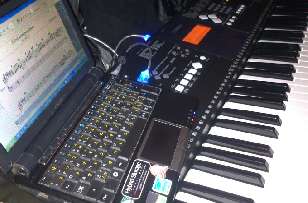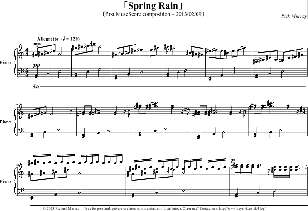Rick's b.log - 2013/02/09
You are 3.147.86.143, pleased to meet you!
Rick's b.log - 2013/02/09 |
|
| It is the 21st of November 2024 You are 3.147.86.143, pleased to meet you! |
|
mailto: blog -at- heyrick -dot- eu
The expressiveness might be harder to explain to people who don't know much about music. Put simply, there are two primary forms of expression on a piano. The first is how hard you hit the keys - a soft touch plays gentle notes, while banging on the keys gives you giant three-dimensional crotchets floating in the air. Whether the orchestra swells for the love scene, or the orgasmic climax of the ultimate rock ballad, how strongly the notes are played makes a huge difference to the overall sound of the piece.
The second part of expressiveness is called sustain. This is managed by a pedal on pianos and keyboards, and its function is to control whether or not a damper presses against the strings of the piano. When the pedal is pressed, the damper moves away so the sound will continue until it dies out naturally. In addition, all of the strings can vibrate in sympathy with the note(s) being played with greatly enriches the sound qualities of the piano. In general, the sympathetic vibration won't be reproduced by an electronic keyboard because it relies upon some complex features of harmonic resonance (thus, different pianos will have slightly different tonal qualities). The alternative is the pedal is not pressed, so the damper rests against the strings, the effect being a note is played and then it dies away almost instantly.
With this in mind, I was looking to get more into playing a keyboard/piano. Now, the little keyboard I got in a vide grenier last year isn't bad for messing around and coming up with unusual sounds, but with tiny keys and a lack of expressiveness, it is going to remain a toy.
Thus, after a little bit of looking around, I got myself a Yamaha PSR E-333. A 61 key full sized keyboard with plenty of features, but one of the better ones is decent sounding voices. Okay, some are a little odd, but many sound sufficiently realistic if played correctly (you can't use the saxaphone voice with piano music and expect good results, you just don't play a saxaphone like that!). There is also USB-MIDI, which required me to download and install a driver but it was all pretty painless. The only thing I cannot do is manual sustain, I need to buy a pedal for that. I will sometime, but since I am using the keyboard on my lap while sitting on my bed (it is large!), there's no realistic way to sustain anyway, unless I wedge the pedal between my legs or something! [yikes]
Frankly, I am crap at playing. I don't have the habit of playing different things with different hands. I hope this won't be a dyspraxia thing and I will improve with time and practice.
[Aside #1: While getting the YouTube links, YouTube suggested this. She's very cute, but the only thing I can imagine is she is singing about... pollen? ]
[Aside #2: From getting more involved with the mechanics of J-Pop, it seems that one of the distingishing factors of what gives it a 'different' sound (other than the obvious of it being sung in Japanese!) is the widespread use of crossbeat. This is particularly evident in Dear You where you can hear the bass line is three notes (a 1-1-2 in a four beat bar) pretty much repeatedly. The notes differ, but the 1-1-2 pattern remains the same. Then the melody, which runs alongside the bass, but with a different timing and rhythm. There is, necessarily, a relationship between the two, but it is nowhere near as direct as contemporary western music.]
For now, I use the keyboard for compositions. Namely, bash out a melody, refine it a little, and then transcribe it to notation.
The first method is a direct transcription of the music as it is played. This tends to create rather horrible notation which is accurate to what was played but not necessarily useful when viewed as notation unless the performer is spot on (to within hundredths of a second) with how the music is performed). More intelligent software will employ a lot of AI to try to match the input music to the formatting of notation without mucking up the notation or changing how the music sounds.
The alternative is to use the keyboard as an input device and only read note pitch/velocity from the keyboard but ignore all timing and such. In this way, you can very accurately transcribe, but you have to understand the music sufficiently to be able to reproduce it one note at a time, altering the note type (crotchet, minim, quaver, etc) once the note has been entered. This is not really so different to using a mouse to draggy-droppy notes, only you are using a real keyboard so it is more familiar than a mouse. MuseScore works in this manner. It is also useful to be able to disable notation input to play with phrases on the keyboard and work out what you want to input before doing so. You have an idea of a melody in your head, it might need a little bit of refinement when it comes to actually playing it. Some people don't have this problem, they can listen to a song once and reproduce it on the instrument of their choosing. I'm not one of those people...
My first half-assed attempt at a composition is called "Spring Rain" and it isn't all that wonderful. It sounds different in my head than the end result, but it is useful to have a concrete end result so I can see where and how things differ. I have not yet got the timing sorted in my head. That will be something to work on.
I am also quite pleased to discover that my keyboard will respond to MIDI files as a sixteen channel synthesiser. I knocked up a few bars of rubbish using a number of different instruments together and it played back correctly. In the future, I can look to thinking of more complete multi-instrument compositions.
I kind of wish I could compose like Jim Steinman, but then somebody who could write such utterly crass lyrics as "the angels had guitars even before they had wings" is probably way out of my league. And the really amusing thing is Steinman has paired up with MeatLoaf who is so much larger than life that he can perform that with a completely straight face (at +3m21s) and - dude, it's rock - you just don't say "huh?". But, then, watch the video - jukebox tombstones bursting out of the ground, smoke, motorbikes, Angelina Jolie... this is so over the top it actually makes the song seem lacklustre in comparison!
Aaaaanyway - to my first composition. Here's the sheet music:
For those who can perform from the tiny pictures, I salute you. For everybody else:
For those who can't sight-read (don't worry, I can't either), there's a MIDI:
And for those who would like to see how crap this is before actually bothering to look at it in any more detail:
For a laugh, I changed the primary voice to tubular bells:
The licence on this is you can listen, use, whatever for private, personal use. Stuff within the "family circle" is okay, so you can inflict this on your little sister as a punishment. Commercial uses and uses where the music is distributed or performed "in public" requires you to contact me first. I will generally say okay if you want to use this in YouTube vids (and provide a link to it here), however commercial use (defined as anything that makes you money) will expect some small amount of currency to be sent my way. That is, once I've picked myself up off the floor after fainting at the idea of somebody actually wanting to use this composition!
There will be more in the future. I trust my capabilities improve so the crotchets floating around in my head resemble the ones on the score!

Spring Rain - piano score
While a little electronic keyboard is fun for messing around with, it seriously lacks two things:
The latter, connectivity, is easy - if it doesn't have MIDI then it is a mere toy. No exceptions.
Listen to the MeatLoaf song "For Crying Out Loud" (eight and a half minutes of rock gold) and you will see the piano starts off very soft, then by the minute marker it cranks up, and then... well then it goes up to eleven.
Cheap keyboards also usually have a sustain button, but it isn't really intended for being switched on and off during a performance.
I am looking to teach myself "Dear You" (Higurashi no Naku Koro ni; see also this (in Japanese)). which isn't that difficult a piece (although you might catch the performer of the linked video is all over the place with the tempo).
I will consider myself capable if/when I can play "Sparkling Daydream" (a lovely transcription of the Chūnibyō Demo Koi ga Shitai! opening song). If you watch the video, listen to how the piano changes how it sounds from 34s to 45s. Sustain, or rather lack of it.
The software I am currently trying out is a free package called MuseScore. It is not bad, but it is fiddly. You see, there are two ways to get notation from performed music.

But, for now, I probably ought to start off without too many complications!


![]()
![]()
Quick dico / crash course for the non-musical or music debutante
These days, for domestic equipment, MIDI data is carried on a USB link. It's a heck of a lot simpler for interfacing to home computers. More expensive equipment needs hellish interconnections so if old-school MIDI is not in use, expect it to turn up in weird styles like ethernet or SCSI.
No comments yet...
| © 2013 Rick Murray |
This web page is licenced for your personal, private, non-commercial use only. No automated processing by advertising systems is permitted. RIPA notice: No consent is given for interception of page transmission. |